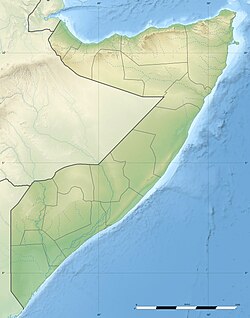
Back كيسمايو Arabic كيسمايو ARZ کیسمایو AZB Kismaayo Catalan Kismayo CEB Kismaayo Czech Kismaayo Danish Kismaayo German Kismajo Esperanto Kismaayo Spanish
Kismayo
Kismaayo كيسمايو Kisimayo Chisimaio | |
|---|---|
City | |
 Overview of Kismayo | |
| Coordinates: 00°21′29″S 042°32′43″E / 0.35806°S 42.54528°E | |
| Country | |
| Regional State | |
| Region | Lower Juba |
| District | Kismayo |
| Area | |
• City | 22.5 km2 (8.7 sq mi) |
| Population (2014)[1] | |
• City | 234,852 |
| • Urban | 458,000 |
| Time zone | UTC+3 (EAT) |
Kismayo (Somali: Kismaayo, Arabic: كيسمايو, Kīsmāyū; Italian: Chisimaio) is a port city in the southern Lower Juba (Jubbada Hoose) province of Somalia. It is the commercial capital of the autonomous Jubaland region.
The city is situated 528 kilometres (328 miles) southwest of the capital Mogadishu, near the mouth of the Jubba River, where it empties into the Indian Ocean. According to the United Nations Development Programme, the city of Kismayo had a population of around 89,333 in 2005.[2]
During the Middle Ages, Kismayo and its surrounding area was part of the Ajuran Empire that governed much of southern Somalia and eastern Ethiopia, with its domain extending from Hafun in the north, to Qelafo in the west, to Kismayo in the south.[3][4]
In the early modern period, Kismayo was ruled by the Geledi Sultanate and by the later 1800s, the Boqow dynasty. The kingdom was eventually incorporated into Italian Somaliland in 1925/6 after the death of the last sultan, Osman Ahmed.[5] After independence in 1960, the city was made the center of the official Kismayo District.
Kismayo was the site of numerous battles during the civil war, from the early 1990s.[6] In late 2006, Islamist militants affiliated with Al-Shabaab gained control of most of the city. To reclaim possession of the territory, a new autonomous regional administration dubbed Azania was announced in 2010 and formalized in 2011. In September 2012, the Somali National Army and AMISOM troops re-captured the city from the Al-Shabaab insurgents.[7] The Juba Interim Administration was established and recognized in 2013.[8]
- ^ PopulationStat Population of Kismayo, city and urban area
- ^ "Regions, districts, and their populations: Somalia 2005 (draft)" (PDF). United Nations Office for the Coordination of Humanitarian Affairs. United Nations Development Programme. Archived from the original (PDF) on 2017-07-28. Retrieved 2020-12-31.
- ^ Lee V. Cassanelli, The shaping of Somali society: reconstructing the history of a pastoral people, 1600–1900, (University of Pennsylvania Press: 1982), p.102.
- ^ Fage, J. D.; Oliver, Roland (1975). The Cambridge History of Africa. Cambridge University Press. p. 137. ISBN 978-0-521-20981-6.
- ^ Cassanelli, Lee Vincent (1973). The Benaadir Past: Essays in Southern Somali History. University Microfilms International. p. 149.
- ^ "From the Bottom Up:—Conflict Dynamics International, Inc". Archived from the original on 2019-07-14.
- ^ Cite error: The named reference
Asaftkwas invoked but never defined (see the help page). - ^ "Somalia: Jubaland gains recognition after intense bilateral talks in Ethiopia". Garowe Online. 28 August 2013. Archived from the original on 12 October 2013. Retrieved 11 September 2013.


